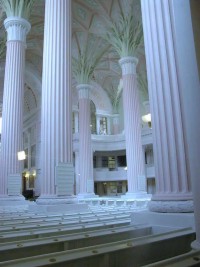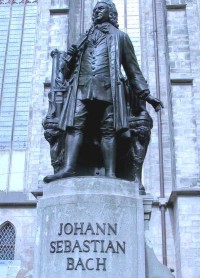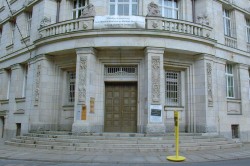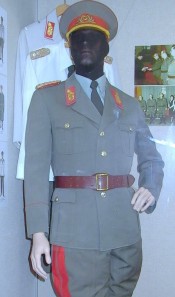VER since Germany was reunited in 1990, the eastern part has been rebuilding, reconstructing, renewing. It has been polishing its image to the point where it is now encouraging visitors to discover the countless treasures embedded in castles, museums and villages. Take Leipzig, a city now ready for prime time. Well worth exploring, we did it in one day.
Think music and you see Leipzig, the birthplace in 1813 of Richard Wagner.
Johann Sebastian Bach was the organist and cantor (choirmaster) of St. Thomas’s Church from 1723 until his death in 1750. He is buried here but his statue stands majestically outside the church. The church was consecrated in 1212 and reconverted in neogothic style in 1884.
Every summer the Leipzig Bach Festival attracts music lovers. You can learn more about Bach’s life at the Bach Museum, which is open year round.

St. Thomas Church |
St. Thomas’s Boys Choir, renowned throughout the world, emerged 800 years ago from the church services at this former Augustinian monastery.
The Gewandhaus orchestra, founded in 1781, had such distinguished conductors as Felix Mendelssohn-Bartholdy, Bruno Walter, and Kurt Masur (who’s now in New York).
Mendelssohn House, where he was born and died, has been restored as a museum dedicated to Leipzig’s first modern conductor.
Mozart also conducted the Gewandhaus in some of his compositions. Mozart Year 2006 will feature a replay of the 1789 Gewandhauss concert on Jan. 27 and 28.
Bach also served as choirmaster and organist at St. Nicholas (Nikolai Kirche), the city’s oldest church. It was built around 1165 in Romanesque architecture, but reconstructed in late 1700s in a classical style. St. Nicholas is the patron saint of travelers and merchants.

Bach at his church |
Strolling this enchanting city we came upon Market Square, where Old Town Hall is situated. An outstanding Renaissance structure of 1556, it is today the City History Museum.
Behind Old Town Hall is the Old Stock Exchange, built in 1687, a gathering place for merchants doing business during the centuries when the city was a flourishing trade center with annual fairs. In front of the exchange stands Johann Wolfgang Goethe.
Leaving Market Square through an arcade, we came upon Haus Zum Arabischen Coffe Baum ("Arabian coffee tree"), the oldest coffee house in Europe (after Café Procope in Paris). It is a coffee temple with a museum documenting the Saxons’ national drink.
The portal features ornate Baroque sculpture, including a relief of a cupid offering a bowl of coffee to a reclining Ottoman. This relief has become the trademark of the Coffe Baum and, according to the museum, "is devoted to the last great cultural gift from the Orient to the Occident after mathematics and gunpowder: coffee."

The Round Corner |
Auerbachs Keller in the magnificent Madlerpassage shopping arcade has been running its historic wine cellar since 1525. This was a favorite hangout for students through the years. www.auerbachs-keller-leipzig.de.
When Goethe came to Leipzig in 1765, he saw paintings of the legend of Faustus on the walls of the pub. He used the Auerbachs barrel cellar for a famous scene in Faust, his most famous work.
Not to be missed is a building called Runde Ecke (Round Corner), located on Dittrichring in the old city. This was the dreaded local headquarters of the East German Ministry of State Security (Stasi). The permanent exhibitions of equipment, uniforms and files show how the 2400 fulltime agents of the secret police forced an ironclad repression on the people under communist rule. They collected all imaginable information about Leipzig citizens.

Stasi uniform |
One display shows the various tools Stasi members had to learn, including gas mask, knife and truncheons. They also used wigs, false beards and secret cameras, such as a camera lens in the push button fastener of a woman’s purse.
Another room holds repression apparatus, a variety of bugging equipment such as a bedpost, fountain pen and wristwatch. The secret agents and their civil collaborators even collected scent specimens from citizens, which were stored in glass jars. Fascinating stuff of a bygone era. www.runde-ecke-leipzig.de.